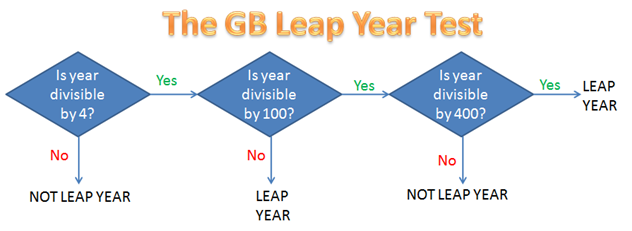The Mathematics of Leap Years Explained
Year 2016 is a leap year!. The years 2000, 2004, 2008 and 2012 are leap years too, so you probably see the pattern that the years divisible by 4 are leap years. Now, is this always true?
The answer is NO. The years 1900, 2100, 2200, and 2300 are divisible by 4, but they are not leap years. Uhm, are all years divisible by 100 not leap years?
The answer is still no. The years 1600, 2000 and 2400 are divisible by 100, but are leap years.
If you are a little bit confused, examine the GB Leap Year Test (wink) diagram below.
As we can see, if a year is divisible by 4 and not divisible by 100, then we are sure that it is a leap year. So, 1924, 1936, 2028 are leap years (Can you give four more examples?).
Now, if a year is divisible by 100, we are not sure if it is a leap year yet; we need to test if it is divisible by 400. If it is divisible by 400, then, it is a leap year, otherwise, it is not. So, 1700, 1800, and 1900 are not leap years, but 1600 and 2000 are leap years.
We can summarize the discussion above as follows.
- Years that are divisible by 4 and not divisible by 100 are leap years.
- Years that are divisible by 100 but not divisible by 400 are NOT leap years.
- Years that are divisible by 400 are leap years. » Read more
